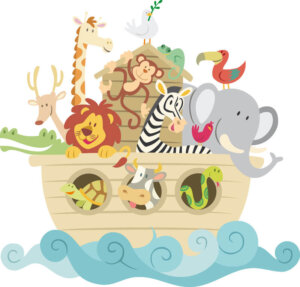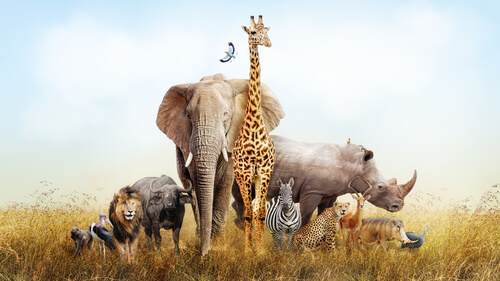Which Animals Went on Noah's Ark?


Written and verified by the biologist Elsa M. de Arribas
In the Bible, specifically in Genesis, it speaks of God’s decision to punish men for their bad behavior. Their actions were tinged with violence and corrupted by sin. Thus begins the story of Noah’s ark, its construction, and the different species of animals he included in it.
According to the written records, Noah had the task of safeguarding at least one pair of each animal that existed on earth. In this way, he hoped to safeguard the future and the repopulation of the planet after the flood. Continue reading this space and discover which animals went on Noah’s ark.
Why was Noah’s ark built?
God ordered Noah, who was considered a righteous man, to build a large ark, where there was to be room for a pair of all the animals in the world. The ark was built of gopher wood and was fitted out so that both animals and humans would be comfortable.
When Noah finished building the ark, God revealed his plan to him. He was going to release a flood that would sweep across the earth and remove evil from it. This meant that the ark would be his salvation, for it would stand up to the water and stay afloat while the calamity occurred.
You might be interested in: 5 Curiosities About the Sea Serpent and Sea Snake
What animals went into Noah’s ark?
The order given was to include a couple of each species of animal so that later the earth could be repopulated. God included all animals, from vertebrates such as reptiles, amphibians, mammals, and birds to invertebrates.
However, God divided the number of individuals of each species according to whether they were “pure animals” or “ungodly animals”. The former would include seven pairs, male and female, while the latter would include only one pair.
Animals considered “pure”
As mentioned earlier, God did not classify all animals equally. He subdivided them into two groups, according to whether he considered them to be pure or impure.
In this section, all the animals that could be eaten by believers are included. This includes some ruminants with cloven hooves, while aquatic animals could only feed on those with fins and scales.
With regard to birds, it allowed feeding on a small group, such as chickens. It allowed eating insects with wings and four legs as long as they moved by hopping, i.e., grasshoppers or crickets.
Thus, God spoke: “Among all the people […], I have seen that you are the only good man. Therefore, enter the ark with all your family. Of all the animals and birds that I accept as offerings, take with you seven pairs, that is, seven males and seven females, so that they may live on the earth.”

Ungodly” or “impure” animals
Concerning the rest of the animals, God said, “Of the animals that I do not accept as an offering, take with you only one pair. In one week’s time I will make it rain 40 days and 40 nights. Thus I will destroy in this world all that I have created.“
The question that arises is which animals God considered impure, since of these only a couple could enter the ark. The list is given in Leviticus 11: 3-6, which explains in detail the characteristics of these animals.
It was forbidden to approach ruminants without cloven hooves, such as the hare, the camel or the rabbit. It was also forbidden to feed on pigs because, although they had hooves, they were not ruminants.
It was forbidden to feed on nocturnal, carrion-eating or large birds, such as ostriches, storks or vultures. Swallows, bats, and owls weren’t permitted either.
Insects with four legs, but with wings, are also impure, as well as all animals that crawl on the ground or have many legs, such as lizards, salamanders, weasels, or centipedes.
When did the first account of Noah’s ark appear?
It was in the year 1844, in the ruins of the Assyrian palace of Nineveh, when Austen Henry Layard found the first cuneiform writing tablets. These tablets are the earliest written record found and they told different stories, some of which also appeared in the Bible.

Among these stories were the Flood and Noah’s ark, the same stories that are in the book of Genesis. But it was not until 1872 that it was realized that these stories were told on these tablets.
Read more: Snakes in Ancient Cultures
This proved, in a way, that the stories in the Bible have a historical background. More tablets were recovered and fragments were completed, which fitted them together like a puzzle. Thus, the oldest story in the world, which has more than 2000 years of history, was reconstructed. This account is called Gilgamesh.
Iconic events of religion can be drawn from books as emblematic as the Bible.
As can be seen, the story of Noah’s ark and the animals he saved has a more enigmatic background than it seems. Although some say the classification into “pure” and “impure” lacks scientific research, others point to some remarkable insights regarding hygiene that people at the time couldn’t have known about.
In the Bible, specifically in Genesis, it speaks of God’s decision to punish men for their bad behavior. Their actions were tinged with violence and corrupted by sin. Thus begins the story of Noah’s ark, its construction, and the different species of animals he included in it.
According to the written records, Noah had the task of safeguarding at least one pair of each animal that existed on earth. In this way, he hoped to safeguard the future and the repopulation of the planet after the flood. Continue reading this space and discover which animals went on Noah’s ark.
Why was Noah’s ark built?
God ordered Noah, who was considered a righteous man, to build a large ark, where there was to be room for a pair of all the animals in the world. The ark was built of gopher wood and was fitted out so that both animals and humans would be comfortable.
When Noah finished building the ark, God revealed his plan to him. He was going to release a flood that would sweep across the earth and remove evil from it. This meant that the ark would be his salvation, for it would stand up to the water and stay afloat while the calamity occurred.
You might be interested in: 5 Curiosities About the Sea Serpent and Sea Snake
What animals went into Noah’s ark?
The order given was to include a couple of each species of animal so that later the earth could be repopulated. God included all animals, from vertebrates such as reptiles, amphibians, mammals, and birds to invertebrates.
However, God divided the number of individuals of each species according to whether they were “pure animals” or “ungodly animals”. The former would include seven pairs, male and female, while the latter would include only one pair.
Animals considered “pure”
As mentioned earlier, God did not classify all animals equally. He subdivided them into two groups, according to whether he considered them to be pure or impure.
In this section, all the animals that could be eaten by believers are included. This includes some ruminants with cloven hooves, while aquatic animals could only feed on those with fins and scales.
With regard to birds, it allowed feeding on a small group, such as chickens. It allowed eating insects with wings and four legs as long as they moved by hopping, i.e., grasshoppers or crickets.
Thus, God spoke: “Among all the people […], I have seen that you are the only good man. Therefore, enter the ark with all your family. Of all the animals and birds that I accept as offerings, take with you seven pairs, that is, seven males and seven females, so that they may live on the earth.”

Ungodly” or “impure” animals
Concerning the rest of the animals, God said, “Of the animals that I do not accept as an offering, take with you only one pair. In one week’s time I will make it rain 40 days and 40 nights. Thus I will destroy in this world all that I have created.“
The question that arises is which animals God considered impure, since of these only a couple could enter the ark. The list is given in Leviticus 11: 3-6, which explains in detail the characteristics of these animals.
It was forbidden to approach ruminants without cloven hooves, such as the hare, the camel or the rabbit. It was also forbidden to feed on pigs because, although they had hooves, they were not ruminants.
It was forbidden to feed on nocturnal, carrion-eating or large birds, such as ostriches, storks or vultures. Swallows, bats, and owls weren’t permitted either.
Insects with four legs, but with wings, are also impure, as well as all animals that crawl on the ground or have many legs, such as lizards, salamanders, weasels, or centipedes.
When did the first account of Noah’s ark appear?
It was in the year 1844, in the ruins of the Assyrian palace of Nineveh, when Austen Henry Layard found the first cuneiform writing tablets. These tablets are the earliest written record found and they told different stories, some of which also appeared in the Bible.

Among these stories were the Flood and Noah’s ark, the same stories that are in the book of Genesis. But it was not until 1872 that it was realized that these stories were told on these tablets.
Read more: Snakes in Ancient Cultures
This proved, in a way, that the stories in the Bible have a historical background. More tablets were recovered and fragments were completed, which fitted them together like a puzzle. Thus, the oldest story in the world, which has more than 2000 years of history, was reconstructed. This account is called Gilgamesh.
Iconic events of religion can be drawn from books as emblematic as the Bible.
As can be seen, the story of Noah’s ark and the animals he saved has a more enigmatic background than it seems. Although some say the classification into “pure” and “impure” lacks scientific research, others point to some remarkable insights regarding hygiene that people at the time couldn’t have known about.
All cited sources were thoroughly reviewed by our team to ensure their quality, reliability, currency, and validity. The bibliography of this article was considered reliable and of academic or scientific accuracy.
-
Bible Gateway. (sf) Levítico 11 TLA. Los animales puros e impuros. Recuperado el 26 de noviembre de 2019, disponible en: https://www.biblegateway.com/passage/?search=Lev%C3%ADtico+11&version=TLA.
-
Smith, F. L. (2008). La Biblia cronologica/The Chronology Bible: Reina-valera 1960, 365 Lecturas Diarias. Editorial Portavoz.
-
Barceló, M. (2017). El Arca de Noé (Vol. 16). Ediciones Universidad de Salamanca.
- Castillo, C. C. (1992). El Arca de Noé en las fuentes árabes. Miscelánea de Estudios Árabes y Hebraicos. Sección Árabe-Islam, 67-78.
This text is provided for informational purposes only and does not replace consultation with a professional. If in doubt, consult your specialist.








